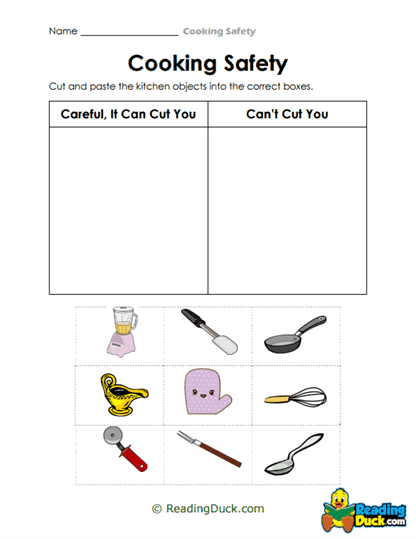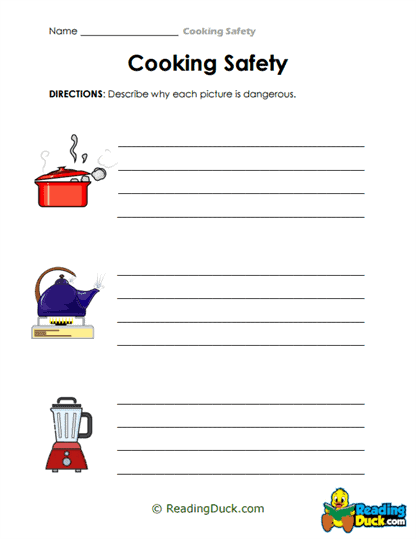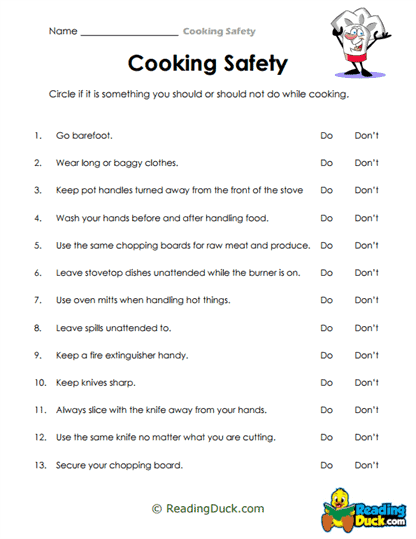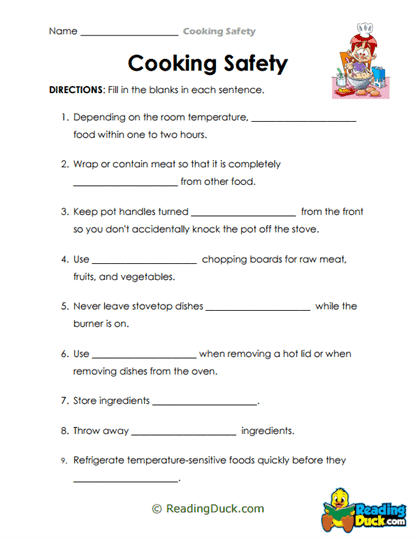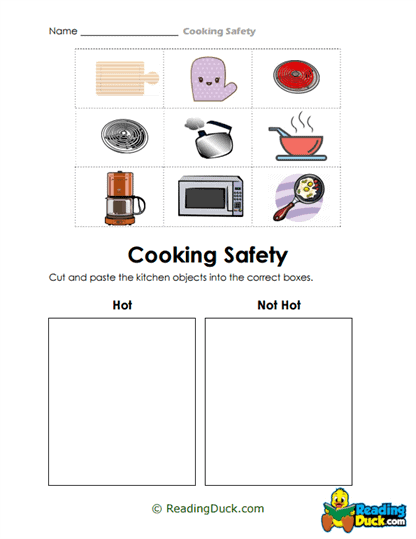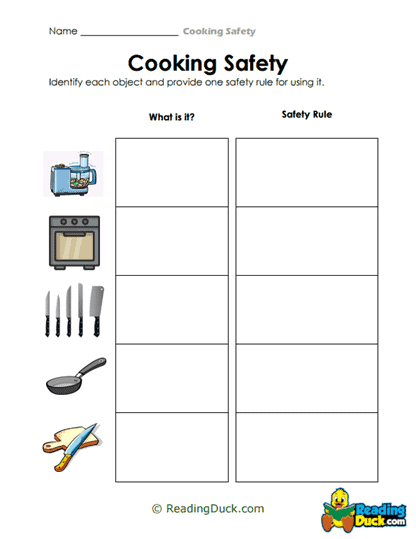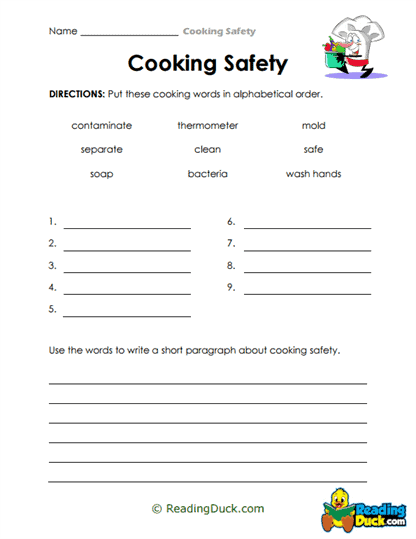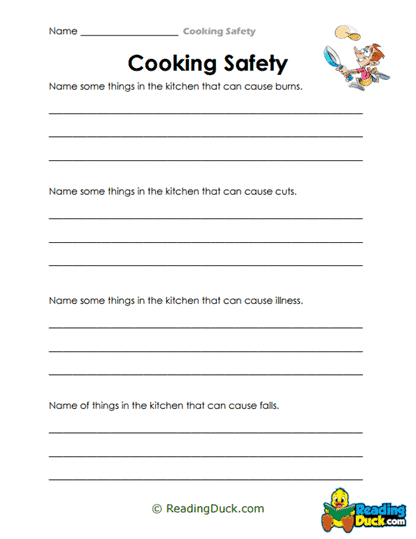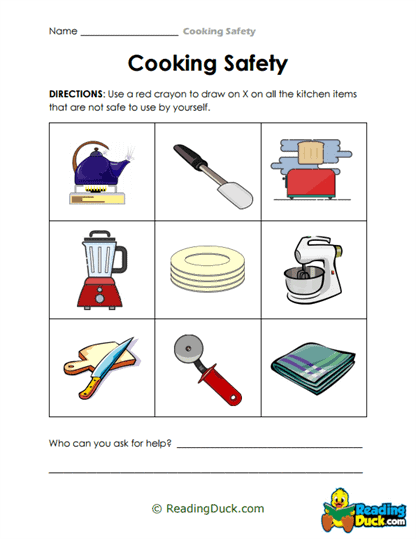Cooking Safety Worksheets
About Our Cooking Safety Worksheets
Our Cooking Safety Worksheets are designed to help students master the essential vocabulary related to cooking safety, an important topic within both culinary arts and everyday life. Knowing the correct terms and procedures related to cooking safety is not only vital for preventing accidents but also for understanding recipes and kitchen instructions. Mastering this vocabulary improves students' language comprehension, allowing them to communicate effectively in both written and spoken contexts about safe practices in the kitchen.
Available in PDF format, the worksheets are easy to download, print, and use across different learning environments. Each worksheet includes a downloadable answer key to make grading and review simple for teachers, parents, and tutors. These worksheets are an excellent resource for helping students develop a thorough understanding of cooking safety terminology, building a strong foundation for both academic learning and practical, real-world skills.
Understanding Cooking Safety Vocabulary: An In-Depth Overview
Cooking safety terminology encompasses a range of terms related to safe practices in the kitchen, from handling equipment to food preparation. Having a solid grasp of this vocabulary ensures that students can follow recipes and kitchen instructions accurately, avoiding common mistakes that can lead to accidents or food contamination.
In the classroom, the topic of cooking safety can be introduced by explaining some fundamental terms and concepts, such as:
- Cross-contamination: The transfer of harmful bacteria from one surface to another, typically from raw to cooked food. Example: "Be sure to avoid cross-contamination by using separate cutting boards for raw meat and vegetables."
- Fire hazard: Any material or situation that could potentially cause a fire, like a dish towel left too close to a hot stove. Example: "Make sure to keep flammable objects away from open flames to reduce the risk of a fire hazard."
- Foodborne illness: Sickness caused by consuming contaminated food, often due to improper food handling. Example: "Always cook poultry to the correct temperature to avoid foodborne illnesses like salmonella."
These terms not only help students understand the importance of cooking safety but also empower them to follow proper procedures in the kitchen. By learning these terms, students build a strong vocabulary base that helps them recognize and apply safe practices, whether they are working in a professional kitchen or preparing a meal at home.
Expanding Vocabulary with Cooking Safety Terms
Mastering cooking safety vocabulary allows students to expand their general vocabulary while developing specialized language skills that are crucial for various real-world contexts. The Cooking Safety Worksheets focus on introducing and reinforcing key terms that are essential for understanding and implementing safety protocols in the kitchen.
Some of the core vocabulary students will encounter in this area includes:
- Sanitization: The process of cleaning surfaces to remove harmful bacteria and other contaminants. Example: "Regular sanitization of work surfaces is important for maintaining a safe cooking environment."
- Temperature control: Ensuring food is cooked and stored at the correct temperatures to prevent the growth of bacteria. Example: "Use a food thermometer to check that meats are cooked to the recommended internal temperature."
- Personal protective equipment (PPE): Gear like aprons, gloves, and oven mitts that protect the user from burns, cuts, or other injuries in the kitchen. Example: "Always wear oven mitts when handling hot cookware to avoid burns."
These worksheets help students practice recognizing these terms in context, improving their comprehension and retention. By engaging with cooking safety vocabulary, students gain a better understanding of how to follow instructions, write clearly about safety procedures, and communicate more effectively in both written and verbal formats.
Versatile Use Across Learning Environments
Our Cooking Safety Worksheets are designed to be flexible, making them suitable for use in a wide range of educational settings, from classrooms to independent study. The worksheets are ideal for reinforcing safety vocabulary in both structured lessons and self-directed learning, helping students build their understanding at their own pace.
- Classroom Integration: Teachers can incorporate these worksheets into lessons on health and safety, home economics, or culinary arts. The worksheets can complement hands-on cooking activities by introducing students to the necessary safety terms before they step into the kitchen.
- Homework Assignments: The worksheets provide an excellent resource for homework, allowing students to review key vocabulary and concepts outside the classroom. This self-paced study helps students internalize the language and concepts at their own speed.
- Independent Study: Whether students are preparing for a test or simply want to improve their cooking safety knowledge, these worksheets are accessible for independent learning. The PDF format ensures students can easily download, print, and use the worksheets, making them a convenient resource for self-study.
The inclusion of answer keys makes it easy for teachers and parents to assess progress, providing quick feedback to ensure students are developing their understanding of the topic.
Practical Applications of Cooking Safety Vocabulary
Understanding cooking safety vocabulary is crucial for more than just academic success; it has practical, real-world implications. Mastering these terms enables students to function safely in any kitchen environment, whether they are preparing a simple meal at home or working in a professional kitchen.
Here are some examples of the practical applications of cooking safety vocabulary:
- Home Cooking: Knowing the correct terms for food handling and preparation allows students to cook safely in their own kitchens. For instance, understanding the concept of cross-contamination helps prevent foodborne illness when preparing meals for family and friends.
- Culinary Careers: For students interested in pursuing careers in the culinary field, mastering cooking safety vocabulary is essential. Professionals in the culinary industry must know how to handle food safely, use personal protective equipment, and prevent accidents in the kitchen.
- Health and Nutrition: Cooking safety vocabulary is also important in the broader context of health and nutrition. Understanding terms like sanitization and temperature control is key to promoting healthy eating habits and reducing the risk of food-related illnesses.
By gaining proficiency in cooking safety terminology, students not only improve their vocabulary but also acquire practical skills that will serve them throughout their lives.
Cooking Safety Vocabulary and Standardized Test Preparation
Cooking safety vocabulary also plays an important role in preparing students for standardized tests, particularly those that assess language comprehension, vocabulary, and real-world problem-solving. Many tests, including the SAT, ACT, and TOEFL, require students to demonstrate their ability to understand and apply specialized vocabulary in context.
The Cooking Safety Worksheets can help students prepare for such tests by:
- Reinforcing Vocabulary Concepts: These worksheets help students become familiar with cooking safety terms, ensuring they can recognize and use them accurately in written and verbal formats.
- Improving Reading Comprehension: Many standardized tests include passages that reference specific procedures or technical instructions, such as those found in a cooking manual or recipe. By learning cooking safety vocabulary, students can better understand such passages and answer related questions with confidence.
- Enhancing Critical Thinking: In addition to learning vocabulary, students can develop critical thinking skills by applying their knowledge of cooking safety to solve problems, such as identifying potential hazards in the kitchen or following a sequence of safety steps in a recipe.
By consistently practicing cooking safety terminology with these worksheets, students can improve both their vocabulary and test-taking skills, making them better prepared for a wide range of academic challenges.
Mastering Cooking Safety Vocabulary for Lifelong Skills
Our Cooking Safety Worksheets offer an engaging and effective way for students to develop their vocabulary and comprehension skills related to kitchen safety. Available in PDF format, these worksheets are flexible enough to be used in various learning environments, from classrooms to home study.
Mastering cooking safety vocabulary is essential not only for academic success but also for practical, real-world applications. Whether students are cooking at home, pursuing a culinary career, or preparing for standardized tests, the ability to understand and apply cooking safety terms is a valuable skill. By learning these terms, students can ensure they follow safe cooking practices, communicate more clearly about food safety, and develop critical thinking skills that will serve them in both personal and professional contexts.
With the help of these worksheets, students can confidently build their vocabulary, deepen their understanding of cooking safety, and acquire essential skills that will last a lifetime. Whether used in the classroom, for homework, or as part of independent study, these worksheets provide a comprehensive resource for mastering cooking safety vocabulary and improving overall language comprehension.
